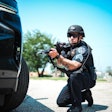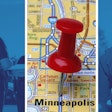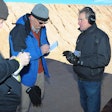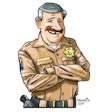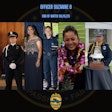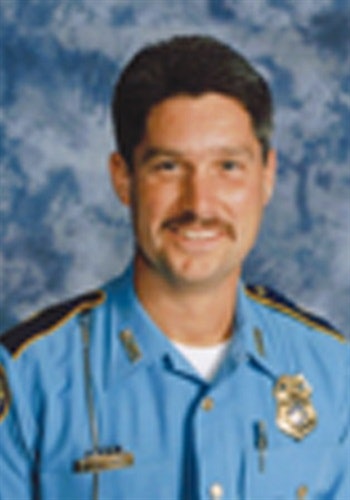
When you're a patrol officer parked roadside on Interstate 55, it's hard for passing cars not to recognize the significance of the two-tone color scheme, light bar, and law enforcement emblem on the side of your patrol car: another roadside distraction for some; another roadside detention for others.
You get accustomed to the double takes, the looky-lous, and the friendly waves of kids through rear windows. And if some passing driver does somehow miss your presence, you can usually count on his passenger to take note of it.
So when two men in a passing Bonneville paid scant attention to him—indeed, made a conspicuous effort to ignore him—Officer Freddy Williams of the Marion (Ark.) Police Department decided to direct his attention to them.
The Bonneville had been picked up by Williams' radar going 76 mph in a 65 mph zone. And when the car passed, Williams recognized the Tennessee "drive off" temporary license and the absence of plates. Between the excessive speed and lack of registration, the patrol officer had more than enough probable cause to stop and detain.
Activating the emergency lights and siren as soon as he hit the interstate, Williams set out after the speeding vehicle. He noted that any willed denial on the part of the men went out the window as the Bonneville began a series of serpentine weaves in and out of traffic.
But if the two men were on to Williams' game, he was equally on to theirs.
A few miles from where Williams had initially observed the Bonneville and well after it should have, the car finally came to a stop off the highway.
Red Flag Warning
Out of habit, Williams unstrapped his holster as he approached the car on foot. The preparatory maneuver was something that he'd adopted early in his career in the belief that it would give him one less thing to worry about if the shit hit the fan. Today, the suspicious behavior of the men in the Bonneville made him more conscious of the effort.
For with their detention, the posture of the suspects went from seemingly apathetic to hyper vigilant. The passenger was particularly nervous, expending considerable amounts of energy to turn around in his seat and keep an eye on Williams. And Williams—whatever his social merits—knew it wasn't his looks or personality that kept the man captivated.
Staying to the rear of the driver's side window, Williams asked the driver for the usual paperwork. In return, he received the man's driver's license and the man's acknowledgment that he'd had the car for two weeks—more than enough time to have gotten the car street legit.
The Bonneville's passenger claimed to have only a birth certificate for identification. Williams looked at the name on the certificate: "Funchez." To Williams, the name sounded a little fishy.
With this scant documentation in hand, Williams cautiously backed up to his patrol car. He noticed that the occupants of the Bonneville took the opportunity to resume their front seat conference.
Williams called dispatch to run their information. The name on the birth certificate returned to a gentleman from Wisconsin.
Red flags were going off on multiple fronts, and Williams wished he could know what manner of shared confidences were taking place inside the Bonneville.
Suspects had a way of telegraphing their punches, and Williams could only wonder what form they would take—and if his backup would get there before they were delivered.
Divide and Conquer
Williams wasn't going to wait for that to happen. He decided to separate the two, opting to remove the driver first. Williams wasn't naïve enough to think he was necessarily safe dealing with the man. But as the driver had thus far displayed a greater degree of cooperation, Williams was willing to gamble that the driver would prove less a threat than his passenger.
Positioning the driver with his back to the car, Williams prevented any further signaling or communications between the two and allowed himself to keep a wary eye on the passenger. After conducting a thorough pat down, Williams sequestered the driver in the backseat of his patrol car.
Williams sat down in the driver's seat of the patrol car and was about to talk to the driver when a curious thing happened: the Bonneville sped off.
Cursing himself for not having had the driver take the keys out of the ignition, Williams radioed dispatch that he was going in pursuit of the Bonneville with its original driver detained in his backseat.
The cars sped off, negotiating a series of turns that eventually found them cutting back northbound on a service road, just below where Williams had made the original stop on the bridge of the interstate. Throughout the pursuit, the fleeing Bonneville made several ditch maneuvers, suggesting to Williams that the driver was thinking about jumping out.
Williams was gaining ground on the Bonneville when its driver suddenly locked the car up. Williams slammed on the brakes of his patrol car, sliding to an offset stop two car lengths back in the oncoming lane.
Williams and the suspect were now situated by a farm field far away from town. As quickly as he had stopped, the passenger lurched his torso outside the driver's window and pointed something in Williams' direction: a gun.
Worst Fears Confirmed
Williams couldn't believe what he was seeing. He felt like a deer transfixed by the headlights of an oncoming car.
The man tilted the gun sideways, gangsta style, his eyes flinched, then—BANG!—he fired.
Everything moved in slow motion for Williams, a frame-by-frame progression of high-resolution images. He could see the projectile as it sailed toward his windshield, pulverizing it. Williams ducked onto the seat, as still more rounds blew out the windshield and passenger window of his patrol vehicle, and the shattered remnants of tempered glass rained down about him.
Williams keyed the mic and yelled out, "Shots fired! Shots fired!"
But Williams' words were lost to his own ears, eclipsed by the barrage of gunfire as the suspect continued to unload into his patrol car.
Williams lay across the front seat, willing himself smaller, to become invisible. But no matter how diminutive he might become, he knew there was a possibility that the man would get out of the Bonneville and charge him for a coup d' grace.
And a coup d' grace would be just that—a finishing off of Officer Williams. Williams realized that he'd already been shot; blood spray was pumping from his face in geysers. He keyed the radio again: "Officer down!"
His transmission inspired a steady stream of radio traffic.
"Where you at?" "What's going on?" "We'll be there!" "How bad is it?"
Shared frequencies meant that Williams was copying transmissions not only from his fellow patrol officers, but from officers and deputies from other agencies, as well. Williams wanted to give updates, to let his fellow officers know what was happening, the safest direction to approach from, and the situation they were rolling into.
But the immediacy of the situation precluded Williams the luxury of communicating such information and more. It was something very much here and now that revolved around his mortality. Williams realized that if he didn't get out of his car it would soon become his death trap.
But it wasn't this thought that prompted Williams to act. No, it was something else that drove him: A mental picture of his son, Dalton.
Will to Survive
Williams had played catch with his son just the day before. It was one of those things that fathers sometimes take for granted. But for Williams, the memory of the previous day took on new significance. He realized that unless he took control of the situation, it could prove to be the last time he would play catch with eight-year-old Dalton.
I can't leave Dalton like this. I've got to get through this for my boy. I won't let him grow up without a father.
Everything seemed to come to a stop, giving Williams time enough to act on his will to survive, and to take the fight to the man who was trying to kill him.
Williams opened the door and jumped out of the patrol car.
His sense of disorientation was profound. He had no sense of where he was, and even if he had time to gather his bearings, his equilibrium was too impaired to allow him to do so. The adrenaline rush of the chase and gunfire remained unabated, and his excited state caused Williams to unconsciously rip the mic out of his radio.
Williams drew his firearm. As he ran toward the back of his patrol car, he laid down suppressive fire to keep the suspect off of him and on the defensive. Taking cover behind the trunk of the patrol car, the officer fired four more rounds.
But Williams felt unsteady; the loss of blood was taking its toll. He surveyed the scene through a crimson cloud. The suspect had rolled his window all the way down and was leaning in and out of the window.
Williams' next shot ricocheted off the top part of the Bonneville's driver's door. Some sense of self-preservation had momentarily prevailed and the suspect ducked down. Williams was heartened by the notion that even if he hadn't quite gotten the upper hand, he was making headway. But he didn't know how much longer he could hold out on his own. Ultimately, he knew that there would be no cavalry to save him. He alone would be responsible for the outcome of this situation.
As Williams wondered how ballistic-friendly the Bonneville's windows and frame were, the suspect suddenly popped back out of the window again and stared back at him. Then he ducked back in again.
Williams realized that his Glock .40 caliber was running dry. He performed a tactical exchange, changing magazines and racking up another round.
But when the suspect turned toward him a third time, he didn't stick his head out the window. Instead, the suspect leaned back for a look at Williams through the back side window. That was to be the last look he'd get at Williams, or any other human being.
For in silhouetting himself to Williams, he gave the patrol officer a perfect target. Williams fired. The suspect's body rotated forward then slipped from view.
Aftermath
Sgt. Kathy Wood arrived on the scene behind Williams. Williams looked back at her, his gun hand still pointed in the suspect's direction. Observing Williams' wounds, Wood pulled out her weapon, and approached the passenger's side of the suspect's vehicle. Peering into the window, she retrieved the suspect's weapon and tossed it out onto the asphalt.
When she walked back to Williams, she said, "I think you killed him."
Williams' sigh of relief was profound. Suddenly the guy in the back seat of his patrol car popped up.
"Don't shoot!" he yelled.
The man's appearance was so sudden and his face so obviously frightened, Williams almost smiled. He let the man know that he'd be safe. There'd been enough shooting for the day.
Later, Williams found out the back story of the men he'd chased. The Bonneville had been carjacked in Memphis a few days prior to Williams making the stop. In addition to several bags of marijuana, the men had two guns in the vehicle—a .45 caliber semi-automatic and a .380. The suspect Williams killed, Anthony A. Harris, 23, was a Gangster Disciple, with warrants out of Milwaukee.
Williams had reconstructive surgery on the right side of his face. A titanium cheek bone and a titanium orbital track were inserted under his right eye, and his sinus cavity and tear duct sack were reconstructed. Three jaw surgeries later, Williams still carries the .45 caliber bullet in his neck between his carotid artery and spine. Doctors have told him that extracting the bullet would cause him more problems than not.
Among the commendations Williams received for his actions that fateful day were the Purple Heart, the Medal of Valor, and the 2003 Officer of the Year Award from the Arkansas Chiefs of Police. That same year, Williams was transferred to the Criminal Investigation Department and promoted to the rank of corporal.
Most importantly, Williams continues to play catch with his son.
What Would You Do?
Put yourself in the shoes of Officer Freddy Williams, pursuing and then conducting a traffic stop on a suspicious vehicle. Then ask yourself the following questions.
- When pursuing vehicles, how much distance do you maintain between yourself and the vehicle pursued? Do you try to stay offset to the right, left, or directly behind? Do you adjust according to the roadway on which you're traveling?
- What is your survival mantra? What thoughts would not only keep you in the fight, but find you coming out on top?
- How optimistic are you about your sidearm's penetration capability? What kind of ammunition do you carry?
- Would you have done anything differently than Officer Williams?










